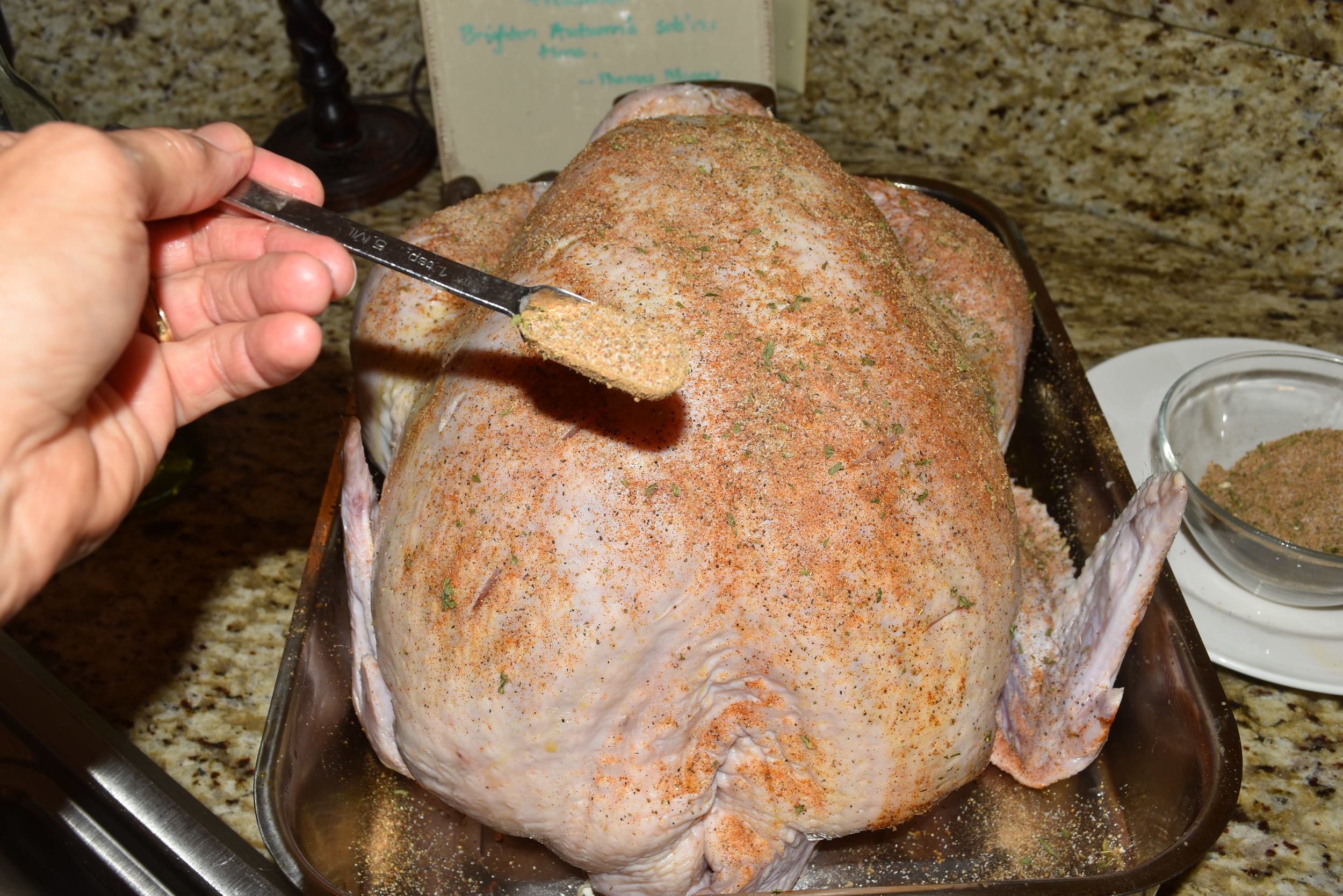In an ever changing world, there is one sure thing you can always count on: deviled turkey in Hershberger homes at Thanksgiving. Ancient folk lure traces the recipe for this spicy bird to my sister, Sharon's mother-in-law, Esther Overholt, more than thirty years ago. Who knows who was marinating this aromatic poultry in a cave full of spices and slow roasting it over an open fire before that? Perhaps the Vikings? This is a recipe for the ages. Once you prepare one of these devilish turkeys, with the aroma wafting through the air, harkening everyone to the kitchen, I dare say you may throw away all your other turkey recipes. Here is some photogenic proof of these drastic claims.
Two year old cousins, Lauren and Brooke, sneaking bites of turkey before dinner.
Deviled Turkey emerging from the oven. May I get a drum roll please?!
When the turkey is being plated, folks line up to be "official tasters."
These are western turkeys, also known as snowbirds.
When its 50+ family members at Thanksgiving, there are several turkeys, requiring all hands on deck.
Derek demonstrates a well balanced turkey plate with all the accoutrements.
Mom always said to clean your plate.
What makes deviled turkey so special, you ask? The bird is rubbed with a blend of eleven spices, covered and refrigerated for 24 hours, and then roasted all day in a slow oven. Every so often, you baste the fowl with the highly seasoned juices that accumulate in the pan. Even the white meat is moist and flavorful. You do sacrifice that really crisp skin, but who would notice with such flavor and aroma! And the juices make spectacular gravy. Talk is cheap; lets get right to the recipe so you too, can prepare this for your friends and family, and be crowned, "domestic goddess."
Deviled Turkey
Large turkey (16-20 lbs), fresh or thawed, with neck and giblets removed
1/3 tsp. salt per pound of turkey
2 Tbsp. black pepper
2 Tbsp. dried sage
2 tsp. curry powder
2 tsp. garlic powder
2 tsp. dried parsley
2 tsp. celery seed
1 tsp. paprika
1/2 tsp. dry mustard
1/4 tsp. allspice
3-4 bay leaves, finely crumbled
Note about size of turkey: this amount of spice mixture makes enough for a good sized bird. If you have a smaller or larger one, just adjust the amount of spices accordingly. It doesn't have to be exact and it will still come out great! Make sure the turkey is completely thawed (or use a fresh one). Remove the neck and the little bag of giblets. I don't care what you do with them; we have a don't ask don't tell policy. Rinse the bird in the sink and pat dry with paper towels. Set the turkey in a large roasting pan and rub with a few tablespoons of olive oil (or melted butter). Using a very sharp knife, make about eight, inch long slits in the breast meat.
Assemble the spice mixture, stirring it together in a little bowl. Generously sprinkle first the underside of the turkey, and then flip it over, breast side up and continue to coat everything with the rub. Throw a bit of it into the cavity and force a little into each slit in the breast meat. Use all the rub to totally coat the turkey. Cover with the roaster cover, or make your own cover with heavy tinfoil, and refrigerate for 24 hours. I usually start this process early on the day before Thanksgiving, to give the bird plenty of time to marinate. Early Thanksgiving morning, preheat the oven to 275-300 degrees. Add a cup of water to the bottom of the roaster, and bake, covered for about 8 hours. After the first few hours, baste the bird every hour or so with the juices in the bottom of the pan. Baste every 30 minutes for the last hour or two of baking. I know that seems like a long time to roast a turkey, but you want it so tender and moist that you barely need to slice it, but rather simply pull the meat off the bones. I always use convection bake and start off at 280 and then some hours into the process, I usually get concerned that it won't be done in time (it always is) and so I turn the heat up to 300 for a few hours and then back down to 280 as I see it nearly finished. You should be able to poke the breast meat with your finger and it gives freely, with very little firmness left. The turkey that I photographed was a large 25 pounder. It took 11 hours to roast. If you have a small ten pound turkey, it might only take 5-6 hours to roast. I try to aim for the bird to be finished a little early; it can sit for at least an hour in the covered roasting pan, before you cut it. Some of my sisters purposely roast their turkeys several hours early, pull off the meat and place it in an oven proof platter, pour some of that wonderful juice over the meat and cover it, popping it back in the oven for a few minutes just before serving.
About that broth; be sure to pour some back on the cut turkey, for even more succulent flavor. Strain the remaining juice and thicken it to make an amazing gravy for the mashed potatoes. I use a slurry of a few spoonfuls of flour dissolved in 1/2 cup of cold water. I add this mixture, a little at a time to the boiling broth, vigorously whisking all the while. Let this cook for a few minutes. Chances are, you won't need any additional salt or pepper for the gravy.
Get your turkey going now, otherwise, like Hewitt and Wilson, you will be so near, but yet so far!


























